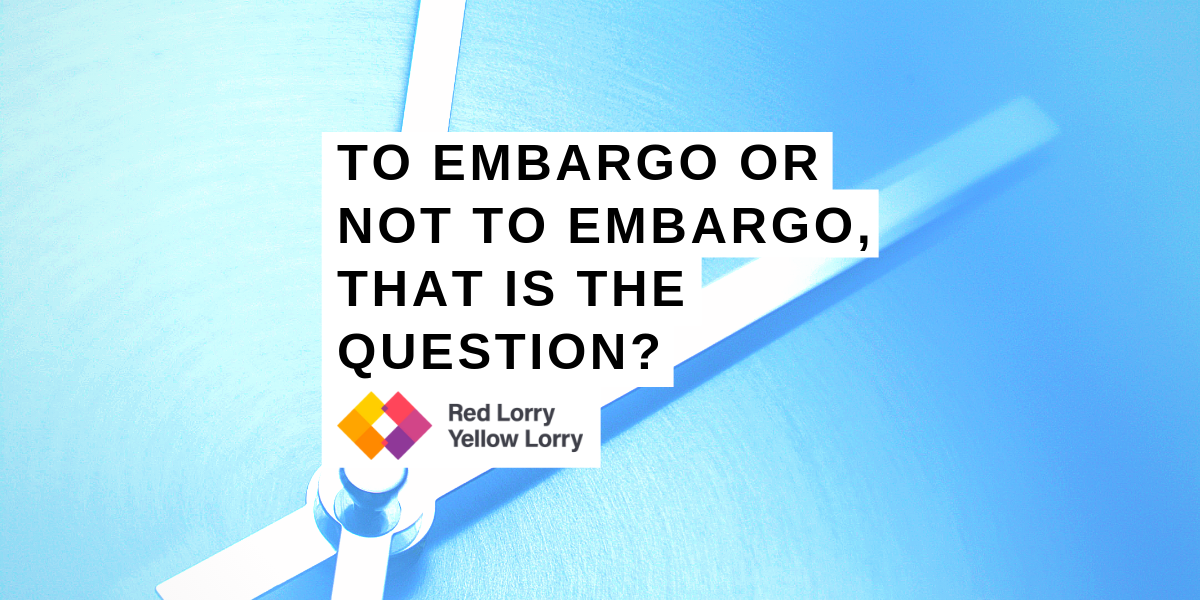Sign up to our newsletter for PR tips and tricks
By Kerry Quintiliani and Justin Ordman
To embargo or not to embargo? This is a question every PR professional asks themselves before developing a strategy for announcing news. Do we give reporters an early look at the story? Or do we wait until the day of before disclosing information?
The answer is frustratingly vague: it depends.
There are many upsides to pitching news under embargo. For instance, it gives reporters extra time to prepare any articles in advance of the news going out. It also buys us more time to pitch other contacts before the news gets old if our original target passes.
But, there are risks, too. For starters, embargoes are merely handshake agreements and not legally binding. There’s nothing stopping a reporter from breaking one if they choose to do so – especially if they think they have a scoop on their hands. Once an embargo is broken, it may disincentivize other reporters from writing a story if they feel like they got the shaft.
The other issue is that, although pitching news day-of may prevent it from being leaked early, many reporters consider it “old” by the time it crosses the wire. Or, breaking industry news may take priority over your announcement, which could bump it to the backburner (or even into the trash).
What it really comes down to is developing strong enough relationships with reporters so you know their preferences and habits when it comes to embargoes. (If you don’t have these, we do! So drop us a line.)
If you do decide to pitch news under embargo, here are a few tips to consider:
- Do your target publications and reporters honor embargoes? Some do not, and it’s best to know this before relaying any of the news. A simple, “Do you honor embargoes?” in your initial email will save you and the reporter both time and headaches in the long run.
- When offering an embargo, get a solid confirmation from the reporter before sending over the news. Without this advanced agreement, you’re basically giving your special news out for free. Reporters who don’t honor embargoes aren’t under any obligation to you just because you include the word EMBARGO in your email. If they decide to run with it in advance of your preferred date/time, there’s nothing you’ll be able to do about it. As they say, you can’t put the toothpaste back in the tube.
- Is your news truly embargo-worthy? Some reporters malign the tendency to over-embargo information that isn’t really important. It’s the PR equivalency of crying wolf. To avoid falling into this bucket, consider how big of a milestone the news is for the company. Take a venture capital announcement as an example; securing funding takes time and announcing a large amount can affect many stakeholders in addition to the impact it has on the business. An embargo in this case makes sense. On the flip side, new hire announcements outside of a C-level appointment won’t get the same level of attention, and therefore can go out to a broader swath of reporters without an embargo.
- Are you targeting the correct publication for your news? If you’re announcing business gains, then consider targeting a top-tier business-focused publication first. If it’s a technical achievement, then consider a publication that covers that area first. Offering a system upgrade to the Wall Street Journal won’t gain as much interest as an announcement about securing millions in funding.
An alternative middle ground
If an embargo isn’t possible, there are some alternatives that could help you get the news into your target publications:
- Offering an exclusive to your top tier publication reporter can work well for both camps. You’ll see the news published in your forum of choice and the publication has the ability to “break” your news before their competitors. Again, an exclusive should be agreed upon before sharing any information.
- Piece your news into categories of interest for specific targets. Offer the larger business story to a key business publication and share the technical angle with a trade book. You can also ask analysts and customers for their perspectives and offer them as part of a case study. Slice and dice your resources so you don’t end up accidentally pigeonholing your news into a single publication. For example, you could offer one publication an interview with your CEO and a briefing with a customer to another.
- Propose a series to your top tier contact. Perhaps they’re not interested in your news alone, but wrapped together with research on trends in the market, it could bloom into a fuller, more in-depth article.
Moving an embargo? Think again.
When it comes to moving embargo dates, the general rule of thumb is…. don’t. Once the horse is out of the barn, it’s very hard to put it back in. Reporters are busy, and often don’t have the luxury of being flexible. Some may ignore the new embargo date, preferring to stick with what they originally agreed to and publish the story anyway. Others may decide it’s not worth the wait, and forego covering the news altogether.

Suggested Post
The dos and don’ts of international PR campaigns
For any brand, expanding into a new region or territory can be a significant challenge. Along with the basic cost of...
Read MoreIn fairness, most reporters are accommodating, but these risks must be considered. Once in a blue moon may be okay, but make a habit of moving embargo dates and you’ll start to get a bad reputation (and grudges are hard to overcome). Therefore, moving embargo dates should only be considered when absolutely necessary, like a company crisis.
There may be quite a lot to think about when it comes to embargos, but the benefits on offer can certainly make it worth the planning and effort. While requesting an embargo isn’t the easiest part of a PR professional’s job, if done correctly, it can yield a top rate piece of coverage worth its weight in gold.
Have you had challenges or success in placing news that was embargoed? Or are you interested in embargo best practices? Drop us a line at hello@rlyl.com or visit our Contact Us page.




